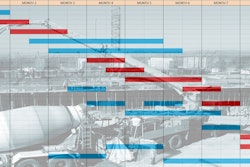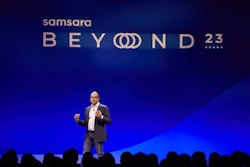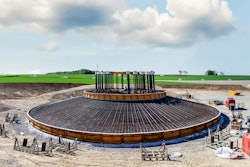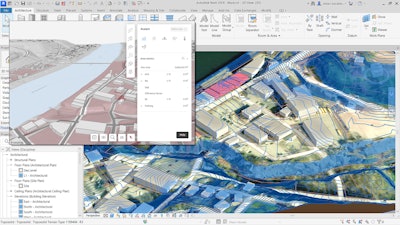
In an announcement today, Autodesk announced the first of what will be a variety of applications under its Autodesk Forma initiative, an artificial intelligence-enabled construction industry cloud intended to extend a single set of data across the design, construction and facilities management/operation phases of built assets.
Included in this release are:
- Contextual modeling to simplify the start of a new building information modeling (BIM) project
- Conceptual design capabilities to enable creative expression of design intent and create 3D renderings
- Automation to speed up exploration of design concepts
- Machine learning for real-time analyses across key density and environmental qualities
- Revit integration
On a call the week before the announcement, most of the questions from journalists were focused on artificial intelligence-related features, including machine learning tools that analyze environmental qualities including sunlight, daylight, wind, and microclimate, reducing the need for technical expertise on the part of the professionals involved.
The more interesting elements of Forma in the intermediate term probably center around the desirability and importance of providing a single body of data to support the asset across its lifecycle, as required by asset management standards including PAS 55 and ISO 55000.
Forma is being built out first, according to executives on the call, for the planning function, and will extend later along the same path projects pass through a building project team, with subsequent phases taking Forma to estimating, construction and facilities management. The initial complement of contextual modeling to speed up creation of a building information modeling (BIM) and accompanying 3D project renderings, design automation and machine learning all focus on the initial project phases. Forma also includes a file-less sync with Autodesk Revit, enabling users to detail their Forma data in Revit and bring it back to Forma for analysis.
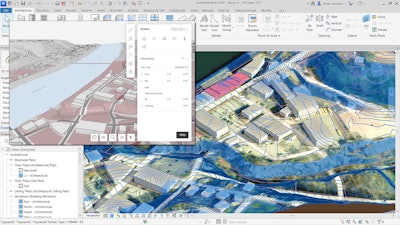 Autodesk Forma-Revit IntegrationAutodesk
Autodesk Forma-Revit IntegrationAutodesk
While AI and machine learning are featured prominently, the automation in Forma is designed more to streamline technical steps rather than take humans out of the equation—a pattern we see with other construction AI initiatives from dozens of progressive vendors bring products to market for contractors and other construction professionals. In the case of Forma, Autodesk executives said the goal is more to meet increasing demand without a proportional increase in hiring.
“Today, automation can help our customers respond to all the demand we talked about,” Autodesk Vice President of AEC Strategy Nicolas Mangon said. “BIM has been wonderful over the last 20 years.
But today, we believe that in addition to CAD processes, we need parametric modeling processes connecting the data to the cloud. We need a new way of working—an outcome-based approach, new processes powered by data and automation to help our customers manage to time, budget and performance outcomes. Our customers will design the outcome they want and ask the co-creation AI to help them deliver the project on this outcome. This is our vision for the future of BIM.”
Confused About Construction AI
The nature of journalist questions on the call suggested that even these apparent insiders may not yet understand AI or how it is coming to market for mission-critical settings. While ChatGPT and generative AI are grabbing headlines, most AI in industry is quietly plugging away, not inventing things like a human, but crunching numbers, evaluating possibilities and solving problems that have more variables than the human mind can deal with.
“AI at launch will be more typically predictive AI for predictions for environmental consequences and better outcomes,” Mangon said. “There is no single AI in Forma. We don't want to position Forma as an AI platform. It is an environment that can get users to better outcomes with different tools. You can get an instant wind, noise, energy and, over time, even a carbon prediction from your design so you can incorporate those outcomes. This requires deep machine learning models that are trained on a number of high-quality, precision analyses to get to those outcomes.”
Quality and precision are two requirements for AI used in applications with substantial real world consequences. Another that underpins all of these other traits is explainability. When ChatGPT generates a piece of text, it cannot cite the sources of its information or explain how it came to various conclusions. There are popular accounts of ChatGPT "hallucinating," or making things up of whole cloth. But if a structural engineer is going to put his or her license on the line certifying an AI-assisted design is sound and conforms to regulations, codes and Newtonian physics, it is important to understand the algorithms and the processes running behind AI. If a contractor is submitting an estimate, they want to know the takeoff performed by a machine learning application is rigorous enough to perform at least as well as a human.
Wrote Julie Gerlings, Arisa Sholo and Ionanna Constantiou in their paper Reviewing the Need for Explainable Artificial Intelligence, “if we cannot explain the algorithms, we cannot argue against them, verify them, improve them, or learn from them.” This, the researchers suggested, mean we need to consider not just the technical problem AI is designed to solve, but the “relations between people, technology, tasks and the organization when developing an evaluation framework for its use in practice.”
The Role of Artificial Intelligence in Construction
According to the 2023 State of the Industry: Construction Technology Report, while only 7% of respondents reporting using AI to date, 64 percent said it would be important within 10 years, and 33 percent within five years.
AI has long been harnessed for takeoffs, enabling software to recognize graphical elements in a set of plans to correctly account for them in an estimate. Even here though, vendors may be throwing their arms around generative AI like ChatGPT while relying on more rigorous AI methods to deliver their core value.
Togal.AI for instance launched in April a ChatGPT function as an as a natural language search tool for construction documents inside the application. Clue Insights, the provider of enterprise asset management software for construction, in May launched a CPT-3.5 algorithm to map scrapers, graders, pavers and dozers and other equipment by class, without human input. These use cases are not central to the solutions’ value proposition though—Togal relies on more explainable construction AI to automate takeoffs, for instance. Procore in 2020 purchased Avata Intelligence, and has used its natural language processing tool in its platform, and has used AI to automate submittals.
On the submittals front, Autodesk is also embedding its acquired Pype application more deeply into its Autodesk Construction Cloud suite of applications.
Countless applications for construction incorporate varying levels of explainable artificial intelligence, not to replace human work as much as to do things in ways humans cannot. Autodesk is not the only vendor moving in this direction—many other vendors have artificial intelligence tools that live in the construction phase. Zetane and Patabaid are both delivering AI-powered estimating.
Zetane’s application is designed to use historical information to inform estimates going forward. This includes not just looking at past estimates, but at change orders on the ensuing projects to identify risks inherent in the design, the project type, the specification or even the customer organization. At Patabid, the goal is to automate the mechanical, electrical and plumbing (MEP) bid generation process with AI and then put insights from this process at the disposal of the project delivery team. A second phase of the project will use AI to identify elements in engineering drawings and schematics and generating an output that can be used in estimating.
One increasingly common use case for AI in construction is the machine computer vision and machine learning functions running under front and rear-facing dash cams on construction equipment and over-the-road vehicles. These cameras are becoming table stakes for construction fleet management applications, and the algorithms therein are trained on extensive historical video footage to recognize unsafe behavior and situations. This method sees more advanced application in safety products like the Blaxtair.
The Blaxtair system is comprised of a stereo camera that compares images in its field of vision to a sophisticated machine learning-generated algorithm to identify pedestrians. The application is now integrated with the Xwatch Safety Systems automated system to slow and even bring to a stop a piece of equipment on which it is installed if a pedestrian is detected. The technology has also been fitted on the turret of excavators to prevent the bucket from swinging and hitting pedestrians.
Other AI tools and vendors that apply AI in explainable ways to real world data include:
- WINT, short for water intelligence, is an AI-drive internet of things (IoT) tool consisting of a cloud-based AI application and an edge unit. The edge unit is a standard off the shelf water flow meter and electronically-controlled valve and a proprietary control unit from WINT that connects valves and meters and processes the data from the meter in real time. The algorithms that spot anomalies in water flow and trigger alerts and water flow stoppages reside on this edge unit
- Photogrammetry products like OpenSpace, that use machine vision to calculate percent complete and track progress.
- Billy, which uses AI to identify gaps in insurance coverage and indemnities to help eliminate risk and legal exposures.
- Applications for offsite construction, like those from SLATE Technologies, harness AI to drive a configuration tool to help manage project outcomes in manufacturing blended construction. In ways, their approach seems to mirror that of Forma in using AI to execute against design intent.
- IFS, the global software company offering enterprise resource planning (ERP) and field service management software to construction also offers its Planning and Scheduling Optimization product with optimizes a schedule in real time—in the case of HVAC contrators like Enercare, this automates the dispatch function as algorithms running in the product can consider more options and combinations routes and make adjustments in real time while considering variables like technician skill set and location, traffic patterns, technician certifications, inventory and tools on the truck, the service level agreement with each customer and more.
- Cummins, which is embedding predictive maintenance intelligence into its telematics solutions, relying on systems integrator Elevat to create a networked approach to diagnosing problems using data from multiple systems, not just the engine itself.
The Future of Construction AI
Taking a consumer technology view of AI in construction will continue to miss the mark. An generative AI app may be able to write an email, create a funny image or write a student-level essay. That is not where the industry is headed—AI used now in the foreseeable future in the industry will not duplicate human creativity, but rather help execute on it in ways the eclipse human analytical capabilities.
This AI does not copy human thinking, but fixes what is wrong with the way our organic brains perceive information and the world.
In Deep Thinking, former World Chess Champion Garry Kasparov’s memoir about events leading up to his crushing defeat by IBM’s Big Blue supercomputer, Kasparov makes clear that the role of computers is not to duplicate the mind of a great player (although he alleges IBM had spies in his camp and human grand masters educating the machine between matches). Rather, the role of AI must be to do what we do poorly, marrying human creativity to unflinching reason and insight underpinned by pure data.
"Computer analysis exploded this lazy tradition of analyzing chess games as if they were fairy tales,” Kasparov wrote. “Engines don't care about story. They expose the reality that the only story in a chess game is each individual move, weak or strong. This isn't nearly as fun or interesting as the narrative method, but it's the truth, and not just in chess. The human need to understand things as a story instead of as a series of discrete events can lead to many flawed conclusions.”
So AI will enable us to design and build in ways that we cannot conceive of, which is necessary to get results that are not possible when the human mind is a constraint rather than a catalyst.





